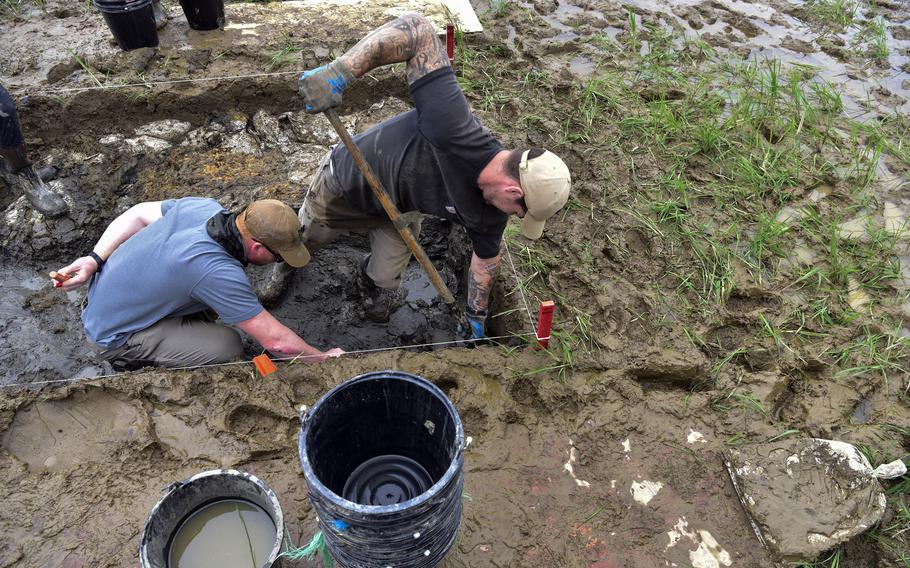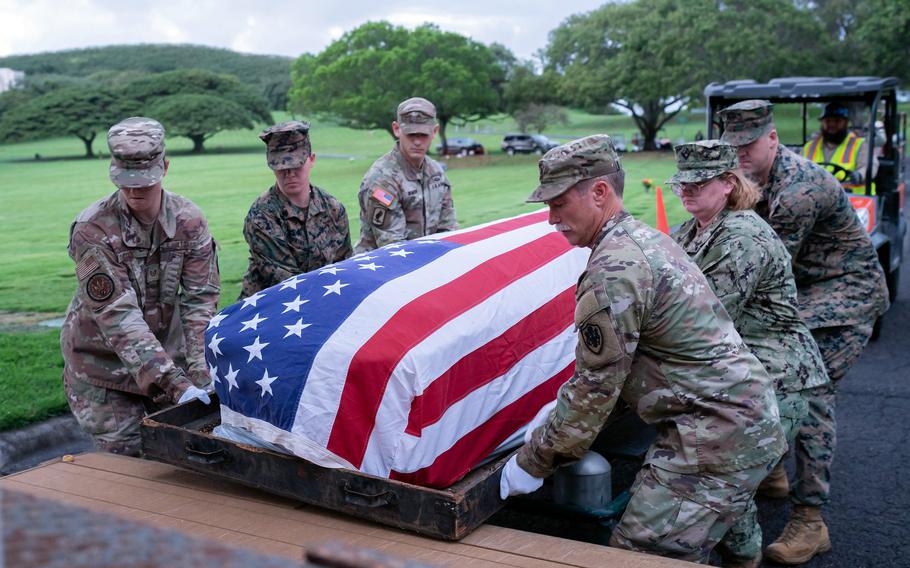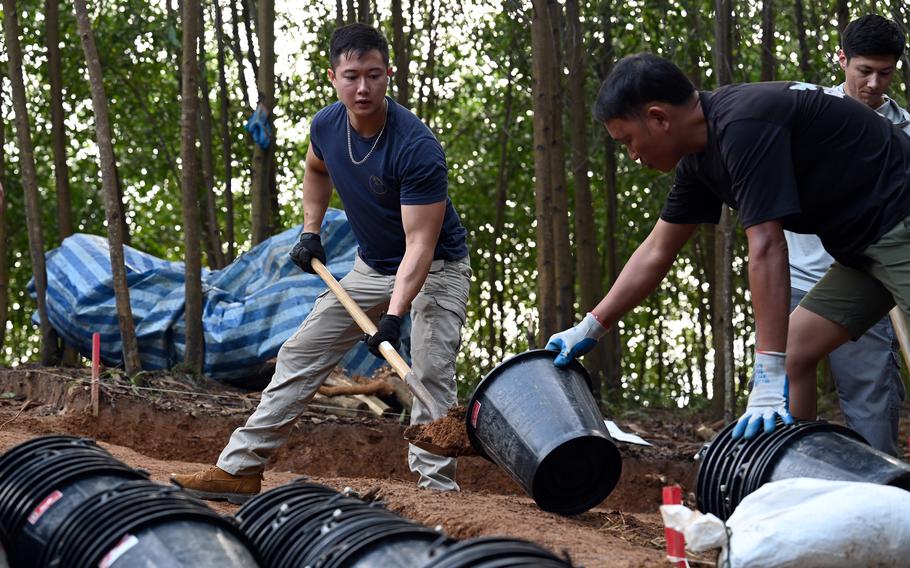
Marine Corps Staff Sgt. Joshua Alexander, left, and Navy Petty Officer 1st Class Joshua Weber, of the Defense POW/MIA Accounting Agency, take part in an excavation in Quang Binh Province, Vietnam, Feb. 26, 2023. (Michael O’Neal/U.S. Army)
JOINT BASE PEARL HARBOR-HICKAM, Hawaii — In August, with the new fiscal year weeks away, the director of the agency tasked with recovering America’s missing war dead was enthused by an additional $40 million in funding and the possibilities ahead.
“We’re very excited about that,” Defense POW-MIA Accounting Agency director Kelly McKeague said during a live video interview with Washington, D.C.-based think tank Center for a New American Security.
“And what that means is that we will be able to triple the number of operations in Southeast Asia,” he said. DPAA’s mission is to retrieve, identify and account for missing service members from wars over the past 80-plus years.
“In some cases, we are quadrupling it,” McKeague said. “It means that we’re able to bring aboard 16 new historians and researchers and a host of other things that allows us to be able to do more and to do it faster.”
Six months later, none of that has happened. The $40 million did not materialize because congressional gridlock has left DPAA and the rest of the Defense Department operating under fiscal year 2023 levels.
Congress instead has passed a series of continuing resolutions, with a partial government shutdown looming again Friday if lawmakers take no further action.
DPAA had planned 165 investigative or recovery missions for fiscal year 2024, which began Oct. 1, Col. Matt Brannen, DPAA deputy director of operations, said Feb. 7 at the agency’s lab at Joint Base Pearl Harbor-Hickam, where he was joined by lab director John Byrd.
That plan represented a roughly 60% increase over the 103 missions completed the previous year. It equated to about a 300% increase in the number of investigative and recovery teams sent into the field, Brannen said.
Halfway through the fiscal year and with that large funding hike “in the mire of continuing resolutions,” the agency will likely conduct just over 100 missions again this year, Brannen said.
Disappearing footprints
DPAA accounted for 158 missing service members during the past fiscal year, which ended Sept. 30, down from 166 the previous year, according to agency records.
These numbers are dwarfed by the scale of the job left ahead in identifying America’s war dead.
About 81,000 Americans are still missing from World War II, the Korean War, the Vietnam War, the Cold War and Gulf Wars, according to DPAA. Almost 90% of those are from World War II.
About 41,000 are presumed lost at sea, making the recovery of many of them unlikely, if not impossible.
Nearly three-quarters of last fiscal year’s 158 total were from World War II, with only four from the Vietnam War, despite the lion’s share of DPAA’s operational funds being dedicated to the latter conflict.

U.S. service members assigned to the Defense POW/MIA Accounting Agency carry out a disinterment ceremony at the National Memorial Cemetery of the Pacific in Honolulu, Hawaii, Jan. 29, 2023. (Edward Randolph/U.S. Army)
About 80% of money allocated for operations, such as for investigation and recovery teams, goes to the Vietnam War recovery effort, Brannen said.
“The goal of making identifications in the Vietnam war effort — that’s our operational priority,” he said.
For some, the results in Southeast Asia amount to too little.
“Four IDs in one year is unacceptable,” Jack McManus, national president of Vietnam Veterans Association, told Stars and Stripes by email Feb. 15.
“Time is our enemy,” he said. “The footprints of battlefields have been destroyed by progress. The acidic soil is eating away at the remains. Many of the veterans are passing on, along with their memories of the battlefield.”
Toughest Vietnam cases
The 1,577 service members still unaccounted for from the Vietnam War, however, are the toughest cases, Byrd said.
“We have over many, many years done all the easy cases there,” he said.
The remaining cases “require a lot more work,” and “there’s a much smaller chance of success on any particular mission that we’re going to run because we’re getting to the point of the most challenging cases,” Byrd said.
Brannen said the agency would make headway in Southeast Asia once the additional teams are deployed with the $40 million increase.
Byrd said he could not say how many identifications the funding increase could lead to, again citing the difficulty of Vietnam War cases.
“But what you do expect is that with a 300% increase in field effort, you expect there to be more IDs than we would make without that effort,” he said. “So, you do expect to make more IDs, to have more success. I just would not want to give somebody the false impression that we’re going to see, you know, massive numbers of identifications come from cases that are so difficult.”

Personnel with the Defense POW/MIA Accounting Agency collect soil during a recovery mission in Vietnam, Nov. 22, 2023. (Ashley Sokolov/U.S. Air Force)
Worldwide disinterment
The 2010 Defense Authorization Act required DOD to fund the recovery effort at a sufficient level that ensures the capacity to account for at least 200 missing individuals each year.
Brannen acknowledged the 200 figure “has translated into a goal” for the agency, which requires balancing time between difficult cases in Southeast Asia with the more straightforward task of exhuming and identifying remains from the graves of unknowns around the world.
“Our disinterment program yields the highest percentage of our identifications, so we work towards that based on the balance,” he said. “But even in those cases, there’s varying levels of results that we see.”
Byrd said he did not expect the agency’s disinterment program to flag this year despite the holdup in additional funding.
“I don’t think we’re going to be negatively impacted by continuing it at FY23 levels,” he said.
The agency completed 211 identifications in fiscal year 2023, but those additional 53 are primarily the remains of service members already accounted for, Byrd said.
For example, some came from the agency’s large, ongoing World War II project at Cabanatuan, the former Japanese prisoner-of-war camp in the Philippines, he said.
More than 2,700 prisoners were buried on the site, some of whom were identified and reburied by the U.S. soon after the war.
“In our pursuit of trying to find the missing persons and identify them, we encounter oftentimes the remains, at least partial remains, of guys that had been identified back in the ‘40s,” Byrd said.
Although those identifications do not contribute to the agency’s annual total, they nevertheless require the same amount of work and analysis as any remains would, Brannen said.
“So, the capacity to do it is there, but ultimately we want to be making new identifications,” he said. “The measure of our success and our impact is really focused on the new identifications.”